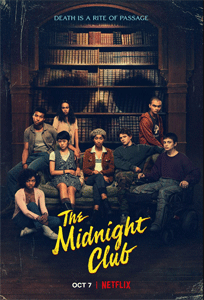A Mike Flanagan Netflix miniseries is now an expected October treat. But “The Midnight Club” is different from “The Haunting of Hill House,” “The Haunting of Bly Manor” and “Midnight Mass” in that it’s in the young-adult genre. It’s adapted from Christopher Pike’s 1990s books, and likewise set in the Nineties, thus allowing for needle drops to (successfully) bait Gen-Xers like me.
This isn’t a case of getting a Fun Size Snickers, though. Thanks to the “Harry Potter” books, the way we look at YA has changed since Pike’s heyday. When watching these 10 episodes, I was never thinking “YA series.” Maybe it’s because these teens have to grow up (and die) fast: They reside at Brightcliffe, a hospice for terminally ill youths.
The beautiful country manor – like a miniature Hogwarts – is possibly haunted, and definitely creepy. Especially once the teens find the secret subbasement that was apparently the site of a sacrificial life-restoring ritual. (Secret subbasements are having a moment: See also the excellent “Evil” Season 3 episode where Ben gets trapped.)
“The Midnight Club” (2022)
Netflix, 10 episodes
Showrunners: Mike Flanagan and Leah Fong, based on Christopher Pike’s novels
Stars: Iman Benson, Ruth Codd, Igby Rigney
Scary even for dying teens
I thought at first that the ghosts and rituals and weirdness of “Midnight Club” can’t be scary, because these kids are dying; nothing can be scarier. No surprise: Flanagan proves me wrong. Because death is – unfortunately but inevitably – the defining factor of their lives, the teens are fascinated by (and scared of) the unknown afterlife.
At their titular club in the common room, they entertain each other by telling spooky stories in throwback fireside chats. (TVs have little presence on this show, aside from one VCR-centered story. And although Sauriyan Sapkota’s MS-afflicted Amesh is a gamer, he plays his PlayStation 1 off screen.) They make a pact that when they die, they’ll work like hell to give a sign from the other side.
Because Flanagan (who writes or co-writes nine of the 10 episodes and directs two) is so good at building realistic worlds with supernatural touches, “Midnight Club” ends up not being ridiculous.
On paper, it’s logistically absurd. This place is a hospice yet the treatments administered by nurse Mark (“Midnight Mass’ ” Zach Gilford) are shown only sporadically. Granted, there are scenes of Ilonka (Iman Benson) and roommate Anya (Ruth Codd) puking from their medications.
But in “The Fault in Our Stars” style, these teens appear outwardly healthy. This is a magic realism of sorts. The showrunners and the viewers make an unspoken pact: None of us want to dwell on the teens’ reality.
Stylized terminal illnesses
Indeed, thyroid cancer sufferer Ilonka has more energy that your average teen. She stays up every night for the Midnight Club and by day visits the neighboring commune of witches in the woods. Head witch Shasta (“Midnight Mass’ ” breakout Samantha Sloyan) says the hospice grounds are magical.
Ilonka investigates the manor’s history (via books and physical explorations), makes pencil drawings of her classmates, and crushes on pasty cancer patient Kevin (Igby Rigney) – to say nothing of coming up with Midnight Club stories when it’s her turn. She rocks Nineties midriff-baring tank tops and never looks tired.
Ilonka’s roommate, wheelchair-bound and Irish-accented Anya, looks the sickliest because Codd has a gumby-like face and she has an awful haircut. But even Anya is bursting with energy – of the angry variety.
Through similarly angry Spencer (Chris Sumpter) – who has that great VCR-based time-travel story — we get a sobering reminder that AIDS used to be deadly. Tragically, if it was only a few years later, he’d likely live a full life thanks to medical advancements.
It wins us over twice
I should admit that Ilonka, Kevin and Anya are the only ones whose names I stored in my memory, but I did like all eight teens. All eight actors are excellent, and I believe them as an octet of mutual love and support.
Flanagan creates true supernatural stakes, but carefully balances this with the reality that the teens are dying. The mystery and adventure might be enough to form a great show, but about half of each episode is taken up by the fireside story told by a member of the Club.
So “Midnight Club” has to win us over twice every episode – and mostly, it succeeds. The closest to a failure is actually episode one’s generic tale of a “Grudge”-like ghost girl who terrorizes some poor schmo. (It should be noted, though, that this tale is sound-designed to play thrillingly if you have a state-of-the-art speaker system, which I don’t. The tale is also the reason the episode set a Guinness World Record for most jump scares, with 21.)
I feared all of the fireside stories might be bland. That soon changes with Kevin’s story of a serial killer (played by Rigney) and Anya’s tale of a split-personality ballet dancer (played by Codd).
These stories are personal. Not literal – they are always supernatural or sci-fi – but drawn from the kids’ real lives. Here, Flanagan illustrates the adage “Write what you know.” This is why these eight terminal teens all happen to be good storytellers – they are recounting their own backgrounds, some thinly disguised, some heavily shrouded.
Over too soon?
The most heated debate between me and my friend who is also watching the series came over these stories. He believed they were random, I believed they said something crucial about the character. In the end, the truth lands in the middle.
“Midnight Club’s” finale plays fair, but it’s not as grim as it could’ve been, based on what’s suggested by Kevin’s story. I said I’d ding the show’s rating if it didn’t pay off Kevin’s arc in a big way. But then Flanagan does his thing of making beautiful art within the horror genre (while still keeping it truly in the horror genre), and he wins me over without giving me the story I hoped for.
Also worthy of discussion: Is this a miniseries or an ongoing series? As you get toward the end, you’ll think “There aren’t enough episodes left to explain everything.” Flanagan’s first three miniseries are complete yarns; this one is not. It even ends on a cliffhanger involving headmistress Dr. Stanton (“Nightmare on Elm Street’s” Heather Langenkamp), a steady but curiously underexplored presence up until then.
There’s no indication of a Season 2, so I guess this is it. Life’s a bitch and then you die, as “Dawson’s Creek’s” Jen Lindley once said (and then embodied, although she made it past the Nineties). We don’t want to watch a season of funerals anyway. Thanks to this talented bunch of writers and young actors, I will remember these youths (even if not their names) as they lived.



Nice thought out review. I must say, however, that several of the teen got a little annoying at times. And they all were know-it-alls. But I guess we all might have been at that age. I am a Flanagan fan.